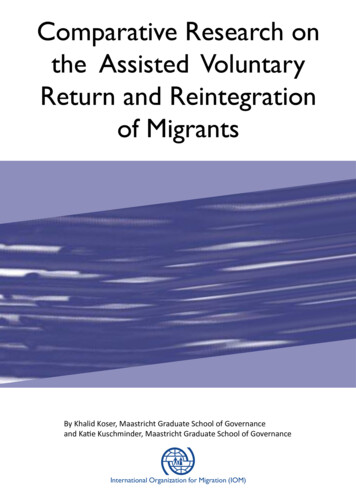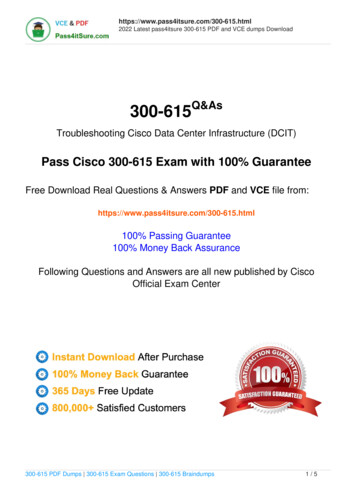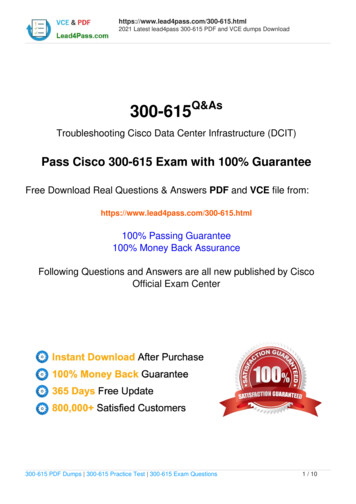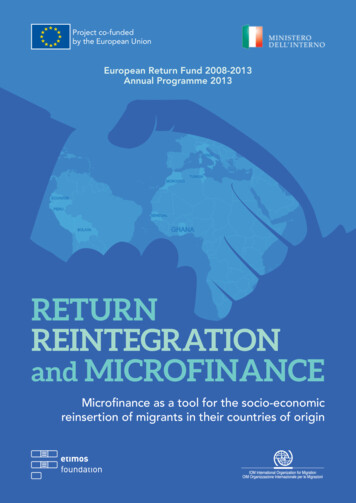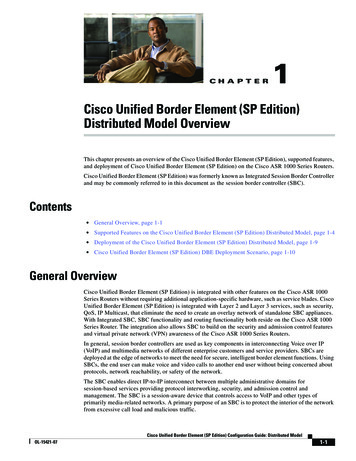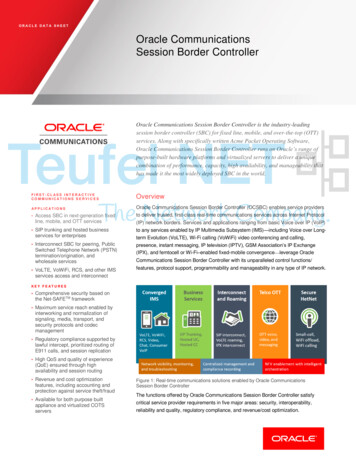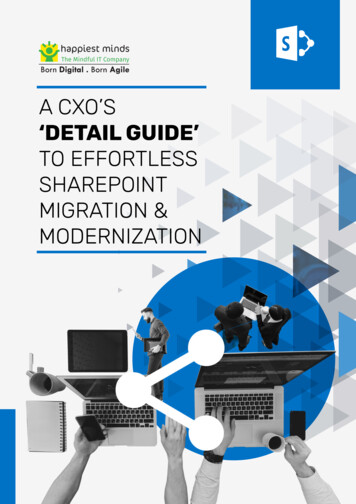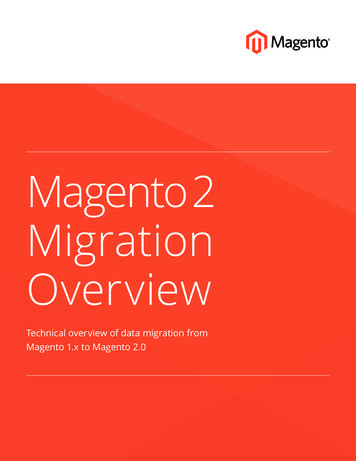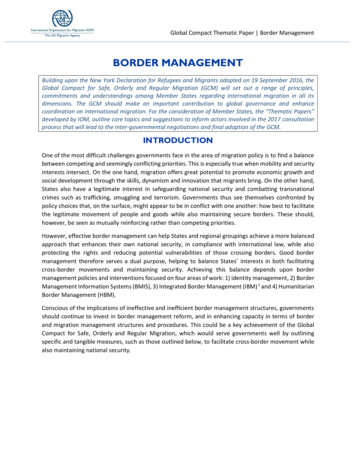
Transcription
Global Compact Thematic Paper Border ManagementBORDER MANAGEMENTBuilding upon the New York Declaration for Refugees and Migrants adopted on 19 September 2016, theGlobal Compact for Safe, Orderly and Regular Migration (GCM) will set out a range of principles,commitments and understandings among Member States regarding international migration in all itsdimensions. The GCM should make an important contribution to global governance and enhancecoordination on international migration. For the consideration of Member States, the “Thematic Papers”developed by IOM, outline core topics and suggestions to inform actors involved in the 2017 consultationprocess that will lead to the inter-governmental negotiations and final adoption of the GCM.INTRODUCTIONOne of the most difficult challenges governments face in the area of migration policy is to find a balancebetween competing and seemingly conflicting priorities. This is especially true when mobility and securityinterests intersect. On the one hand, migration offers great potential to promote economic growth andsocial development through the skills, dynamism and innovation that migrants bring. On the other hand,States also have a legitimate interest in safeguarding national security and combatting transnationalcrimes such as trafficking, smuggling and terrorism. Governments thus see themselves confronted bypolicy choices that, on the surface, might appear to be in conflict with one another: how best to facilitatethe legitimate movement of people and goods while also maintaining secure borders. These should,however, be seen as mutually reinforcing rather than competing priorities.However, effective border management can help States and regional groupings achieve a more balancedapproach that enhances their own national security, in compliance with international law, while alsoprotecting the rights and reducing potential vulnerabilities of those crossing borders. Good bordermanagement therefore serves a dual purpose, helping to balance States’ interests in both facilitatingcross-border movements and maintaining security. Achieving this balance depends upon bordermanagement policies and interventions focused on four areas of work: 1) identity management, 2) BorderManagement Information Systems (BMIS), 3) Integrated Border Management (IBM) 1 and 4) HumanitarianBorder Management (HBM).Conscious of the implications of ineffective and inefficient border management structures, governmentsshould continue to invest in border management reform, and in enhancing capacity in terms of borderand migration management structures and procedures. This could be a key achievement of the GlobalCompact for Safe, Orderly and Regular Migration, which would serve governments well by outliningspecific and tangible measures, such as those outlined below, to facilitate cross-border movement whilealso maintaining national security.
Global Compact Thematic Paper Border ManagementEXISTING PRINCIPLESGovernments have committed to a range of legal and operational norms that relate to bordermanagement issues. In many cases, these existing principles and commitments also reflect the duality ofinterventions in this area. For example, the core body of international human rights law to whichgovernments have committed themselves are critical to promoting more dignified, orderly and safemovement across borders. This is especially important to protect the human rights of migrant populationsduring crisis situations. At the same time, various other norms and standards call for government actionto disrupt the trafficking of human beings, smuggling of migrants and to prevent the movement ofterrorists.Normative FrameworkAlthough States are entitled to exercise sovereign jurisdiction at their international borders, all bordermanagement interventions must be carried out in accordance with States’ obligations under internationallaw. In particular, governments must ensure that the human rights of all persons at international bordersare fully respected, protected and fulfilled. These rights and obligations are set out in the coreinternational human rights instruments, including the Universal Declaration of Human Rights,2 theInternational Covenant on Civil and Political Rights, the International Covenant on Economic, Social andCultural Rights,3 the Convention relating to the Status of Refugees4 and the Protocols thereto, theConvention on the Elimination of All Forms of Racial Discrimination,5 the Convention on the Eliminationof All Forms of Discrimination against Women,6 the Convention against Torture7 and the Convention onthe Rights of the Child.8For Humanitarian Border Management (HBM), the four Geneva Conventions adopted in 1949 and the1977 Protocols9 as well as The Hague Conventions 1899 and 190710 apply. Of the Geneva Conventions, itis especially the Fourth Geneva Convention protecting civilians in international conflict11 and CommonArticle 312 that are of relevance.Commitments on border management and securityThe World Trade Organization’s (WTO) Doha Development Agenda, adopted during the Hong KongMinisterial Conference, commits its members to taking “additional measures to provide effective marketaccess, both at the border and otherwise”.13 The Addis Ababa Action Agenda further states that the“improvement of trade- and transit-related logistics” to facilitate transport and trade, especially forlandlocked developing countries is needed.14In the context of enhancing border management to combat transnational organized crime and terrorism,the United Nations (UN) have passed several resolutions, conventions and protocols that provide theinternational legal basis for robust Identity Management, enhanced Integrated Border Management andthe use of Border Management Information Systems (BMIS).For the purposes of combating transnational organized crime, the UN Convention against TransnationalOrganized Crime and the Protocols thereto15 provide the starting point. The Convention sets out theobligations of ratifying States domestically and encourages international cooperation to disrupt thetrafficking of human beings, smuggling of migrants and the illicit production and trafficking of firearms. Itincludes provisions on document security and controls16 as well as on the collection, analysis and exchangeof information at borders.17Page 2 of 8
Global Compact Thematic Paper Border ManagementFor the purposes of countering terrorism, the UN Global Counter-Terrorism Strategy18 and SecurityCouncil resolutions 1373 (2001),19 1566 (2004),20 1624 (2005)21 and 2178 (2014)22 are relevant. Thesecharge States with the establishment of “effective border controls and controls on issuance of identitypapers and travel documents”,23 the improvement of data collection24 and the timely exchange ofaccurate operational information25 to prevent terrorists from crossing international borders.The Sustainable Development GoalsBorder management interventions can contribute to meeting several targets under the SustainableDevelopment Goals (SDGs). Prime among these is goal 10, target 10.7: “Facilitate orderly, safe, regularand responsible migration and mobility of people, including through the implementation of planned andwell-managed migration policies”.26 In addition, several targets in goals 9, 16 and 17 also touch uponeffective border management. In respective order, these aim to “build resilient infrastructure, promoteinclusive and sustainable industrialization and foster innovation”, “promote peaceful and inclusivesocieties for sustainable development, provide access to justice for all and build effective, accountableand inclusive institutions at all levels” and “strengthen the means of implementation and revitalize theglobal partnership for sustainable development”.27Briefly, better border management contributes to these targets in the following ways: First, by buildinggovernments’ capacities to implement well-managed migration policies for better border management,migration is made more orderly, safe, regular and responsible (Target 10.7).28Second, by supporting concrete green measures related to border infrastructure, for instance includingrenewable power sources (solar panels) in the construction and refurbishment of remote border posts,States, with the international community’s assistance, are able to make a contribution to the retrospectiveupgrade of sustainable trans-border infrastructure (Targets 9.1, 9.4 and 9.a).Third, moving towards greater intra-service, inter-service, bilateral, regional and internationalcooperation in border management will help combat transnational organized crime and terrorism(Targets 16.4 and 16.a) and reduce the incidence of corruption and bribery (Target 16.5).Fourth, building States’ capacity to implement robust Identity Management frameworks empowerspeople including migrants, supports the reduction of illicit cross-border movements of both people andgoods (Target 16.4, 16.a) and helps identify and protect vulnerable migrants and refugees, enablingborder agencies to refer those in need of protection or assistance to the appropriate bodies. This includesthe provision of reliable and secure legal identity for all (Target 16.9),29 instituting measures to ensuretravel and identity document security, and building border officials’ capacity to detect false, forged orstolen travel documents.Fifth, implementing Border Management Information Systems (BMIS) can contribute to the collection ofreliable data disaggregated by gender, age, migratory status and geographic location (Targets 17.18 and17.19) at the border and will greatly enhance States’ capacity to develop evidence-based migrationpolicies.30Page 3 of 8
Global Compact Thematic Paper Border ManagementThe Migration Governance FrameworkThe International Organization for Migration’s (IOM) Migration Governance Framework (MiGOF)summarizes the essential elements for well-managed migration.31 The Framework articulates a set ofthree principles and objectives that are of relevance to different aspects of border management.Principles 1, 2 and 3 as well as Objectives 2 and 3 apply here. These are as follows:Principle 1: Good migration governance would require adherence to international standards andthe fulfilment of migrants’ rights [ ]Principle 2: Migration and related policies are best formulated using evidence and whole-ofgovernment approaches [ ]Principle 3: Good migration governance relies on strong partnerships [ ]Objective 2: Good migration governance is based on effective responses to the mobilitydimensions of crises [ ]Objective 3: Migration should take place in a safe, orderly and dignified manner [ ]32Of these Principles and Objectives, the following are relevant to border management: first, all suggestedactions must be implemented in compliance with international standards giving full respect to migrants’rights (Principle 1). Second, providing governments with BMIS builds their capacity to establish and drawon a sound evidence base for the development of migration policy (Principle 2). Third, enhancingcooperation at all levels by instituting Integrated Border Management agreements bilaterally as well asregionally fosters closer and more effective partnerships within and among governments (Principle 3).Fourth, ensuring transit and destination countries are equipped to address large influxes of crisis-affectedmigrants and provide them with the care and protection required by means of HBM programming makeseffective responses to the mobility dimension of crises possible (Objective 2). And fifth, addressing therisks associated with migration improves safety and security for all (Objective 3).ISSUESStates have a strong interest in facilitating legitimate forms of migration. It contributes in many ways totheir social and economic development owing to the diverse contributions of migrants. Indeed, as theSutherland Report points out, “[w]ithout migration, our societies would never have achieved their currentlevel of development”.33 However, States also have an interest, and indeed, a responsibility, to protecttheir citizens and national interests, subject to applicable international law. This is especially critical inlight of the challenges presented by the unregulated movement of large numbers of people, as well as thepotential risks of human smuggling or trafficking. With terrorist activity on the rise since the late 1990s,34States have also been under growing pressure to detect possible terrorists and prevent them fromcrossing international borders. Forced and irregular migration similarly create significant risks for migrantsas well as their countries and communities of origin, transit and destination, which frequently do notpossess the capacities or resources to adequately identify and refer those entering their territoryirregularly.The potential tension between these dual objectives means that there is a constant need to harmonizeand streamline migration policies and processes, in particular at the border. The outcome of the BerneInitiative – the International Agenda for Migration Management (IAMM) – similarly highlights that acomprehensive national migration policy would consider the various interrelationships between differentPage 4 of 8
Global Compact Thematic Paper Border Managementpolicy domains, for example in the economic, social, cultural and security domains. It further notes that“effective national migration policy needs to find and maintain a balance among measures addressingvarious migration-related issues”.35 Comprehensive and well-functioning border management structurescan help achieve that balance, encompassing both security and facilitation of legitimate cross-borderflows of people and goods.Interventions in different areas of border management respond to this need in different ways. To helpStates strengthen their capacities to identify, screen and properly treat and refer those crossing theirborders, the Global Compact might outline practical means for governments to improve existing IdentityManagement frameworks. It may further help governments collect reliable and accurate information atborders by introducing software-based solutions such as BMIS. Encouraging information sharing throughgreater domestic, bilateral and international collaboration – Integrated Border Management – furtherimproves the levels of security that States are able to afford their own residents as well as migrants. Inthe event of large-scale movements, government capacity to intervene before, during and after crisesmust be improved for the protection of migrants’ rights.SUGGESTED ACTIONSThe actions suggested here are designed to promote the balance between facilitation of cross-bordermovement and the need to uphold national security. Supporting States’ efforts to establish or enhanceIdentity Management processes and frameworks facilitates migrants’ mobility as well as improvingaccurate identification, and with that control, at borders. Using a Border Management Information Systemto process those crossing borders provides a standardized means to collect data, cutting down processingtimes and error rates associated with paper-based systems. At the same time, it affords governments thepossibility of improving both border and national security by verifying certain features of documentsecurity and checking travellers against both national and INTERPOL alert lists. Integrated BorderManagement ensures customs and immigration processes are streamlined as much as possible andimproves information sharing at several levels, providing actionable information in a timely manner.Humanitarian Border Management aims to ensure migrants in emergency situations are able to crossborders when they need to, while maintaining necessary levels of control. Greater detail on each of theseareas of intervention is provided below.1) Identity ManagementTo bolster governments’ Identity Management capabilities, the Global Compact may help registeringall citizens at birth, consulting on document security, reviewing travel document issuance processesand facilitating the issuance of reliable identity documents. To ensure that false or fraudulent traveldocuments are flagged at the point of entry, States may also wish to avail themselves of internationalorganizations’ expertise on travel document inspection. This includes training frontline border officialson how to recognize imposters, signs of tampering and false travel documents, ensuring secondaryinspection laboratories are adequately staffed and equipped and may also extend to setting upregional document examination centres for the referral, verification and storage of suspectdocuments.Page 5 of 8
Global Compact Thematic Paper Border Management2) Border Management Information SystemsThe use of a Border Management Information System (BMIS) allows governments to collect, process,store and analyze information on migrants’ and refugees’ arrival and departure. It ideally does so inreal time, allowing border officials to form an accurate picture of cross-border movements andaffording them the ability to create evidence-based traveler risk profiles. Over the long term, datacollected by a BMIS can be used to inform sound migration management policy, improvinggovernment capacities to plan and prepare. A BMIS may also be used to improve border security – byproviding connectivity with INTERPOL’s alert lists, it becomes possible to identify both suspect personsand documents at the point of entry. Where such a computerized system is in place, security canfurther be enhanced by establishing Advance Passenger Information (API) notifications atinternational airports. BMIS may also help harmonize procedures by serving as a uniform mechanismfor processing.3) Integrated Border ManagementGovernments may wish to encourage closer cooperation between their own customs and immigrationservices and those of other countries. The European Commission has developed the concept ofIntegrated Border Management (IBM) (also referred to as Coordinated Border Management by theWorld Customs Organization) to describe this approach. By establishing close cooperation at the interservice, inter-agency and international levels, IBM seeks to minimize duplication and maximizeefficient and effective use of resources at border posts. A model that has been enjoying much successin the sub-Saharan African context is that of One-Stop Border Posts (OSBPs). Specifically designed tooptimize processing times at border crossing points along major trade routes, OSBPs house borderservices of neighbouring countries in the same structure, significantly improving cooperation,effectiveness and waiting times.4) Humanitarian Border ManagementHumanitarian Border Management (HBM) is a key sector in IOM’s Migration Crisis OperationalFramework (MCOF)36 and describes the border operations before, during and after humanitariancrises, involving large-scale cross-border movements. Applied correctly, HBM interventions protectcrisis-affected individuals, including their right to non-refoulement, while respecting nationalsovereignty and security. Assistance to governments on building their HBM capacity involves, interalia, putting in place that there are standard operating procedures (SOPs) to address sudden changesin the number of cross-border movements, developing and implementing emergency preparednessand contingency plans, establishing referral systems to ensure vulnerable migrants are assisted in thefastest way possible, and creating inter-agency cooperation mechanisms for a coherent response inthe event of a crisis.Beyond these measures, better border management is assured by identifying gaps by means ofcomprehensive border and migration management assessments, targeted and tailored provision ofspecialist training to border services’ staff, the development and implementation of SOPs and byconstructing the necessary facilities as well as equipping them with the relevant tools.Page 6 of 8
Global Compact Thematic Paper Border Management1Also known as Coordinated Border Management (CBM), cf. World Customs Organization (WCO), (2009)Coordinated Border Management – A Concept Paper, WCO Research Series.2Though this is non-binding. General Assembly resolution, The Universal Declaration of Human Rights,A/RES/3/217 A, 10 December 1948.3General Assembly resolution, International Covenant on Economic, Social and Cultural Rights, InternationalCovenant on Civil and Political Rights and Optional Protocol to the International Covenant on Civil and PoliticalRights, A/RES/21/2200, 16 December 1966.4General Assembly resolution, Convention relating to the Status of Refugees, A/RES/429, 14 December 1950.5General Assembly resolution, International Convention on the Elimination of All Forms of Racial Discrimination,21 December 1965, United Nations, Treaty Series, vol. 660, p. 195.6General Assembly resolution, Convention on the Elimination of All Forms of Discrimination against Women,A/RES/34/180, 7 November 1967.7General Assembly resolution, Convention against Torture and Other Cruel, Inhuman orDegrading Treatment or Punishment, A/RES/39/46, 10 December 1984.8See t/crc.pdf9See tions.htm10Convention (I) for the Amelioration of the Condition of the Wounded and Sick in Armed Forces in the Field,Geneva, 12 August 1949; Convention (II) for the Amelioration of the Condition of Wounded, Sick and ShipwreckedMembers of Armed Forces at Sea, Geneva, 12 August 1949; Convention (III) relative to the Treatment of Prisonersof War, Geneva, 12 August 1949; Convention (IV) relative to the Protection of Civilian Persons in Time of War,Geneva, 12 August 1949, available from: vwTreatiesByDate.xsp11Convention (IV) relative to the Protection of Civilian Persons in Time of War, Geneva, 12 August 1949, availablefrom: vwTreatiesByDate.xsp12Cf. Article 3, Convention (I) for the Amelioration of the Condition of the Wounded and Sick in Armed Forces inthe Field, Geneva, 12 August 1949, available from: See ebART/365-570006?OpenDocument13WTO, DOHA WORK PROGRAMME – Ministerial Declaration, WT/MIN(05)/DEC, 22 December 2005, p. 9.14General Assembly resolution, Addis Ababa Action Agenda of the Third International Conference on Financing forDevelopment (Addis Ababa Action Agenda), A/RES/69/313, 17 August 2015, p. 42.15General Assembly resolution, United Nations Convention against Transnational Organized Crime, A/RES/55/25, 8January 2001.16Ibid., p.4817Ibid., p. 3018General Assembly resolution, The United Nations Global Counter-Terrorism Strategy, A/RES/60/288, 8September 2006.19Security Council resolution, S/RES/1373 (2001), 28 September 2001.20Security Council resolution, S/RES/1566 (2004), 8 October 2004.21Security Council resolution, S/RES/1624 (2005), 14 September 2005.22Security Council resolution, S/RES/2178 (2014), 24 September 2014.23Security Council resolution, S/RES/1373 (2001) p. 2, Security Council resolution, S/RES/1624 (2005) p. 3 andSecurity Council resolution, S/RES/2178 (2014) p. 4.24Security Council resolution, S/RES/2178 (2014) p. 4.25Cf. General Assembly resolution, A/RES/60/288 Pillar III, Security Council resolution, S/RES/1373 (2001) p.2,S/RES/1624 (2005) p. 3 and Security Council resolution, S/RES/2178 (2014) p. 4.26Ibid., p. 21.27Ibid., pp. 20, 25, 2628Improving States’ capacities for better migration governance is also highlighted as a recommendation in theSecretary-General’s Special Representative for Migration’s Report to the General Assembly; recommendation 11”Invest in State capacities to manage migration” calls for the creation of a financial facility to this end, cf. GeneralPage 7 of 8
Global Compact Thematic Paper Border ManagementAssembly, Integrated and coordinated implementation of and follow-up to outcomes of the major United Nationsconferences and summits in the economic, social and related fields, A/71/728, 3 February 2017, p. 24.29Providing legal identity for all also features in the Special Representative’s report as recommendation 10 “Fosterinclusion by equipping migrants with a proof of legal identity”, ibid., p. 23.30Recommendation 12 of the Special Representative’s report stresses the need to “Improve data for fact-basedmigration policies and accountability”, ibid., p. 25.31IOM Council, MIGRATION GOVERNANCE FRAMEWORK: The essential elements for facilitating orderly, safe,regular and responsible migration and mobility of people through planned and well-managed migration policies,C/106/40, 4 November 2015.32 Ibid., pp. 2-6.33United Nations General Assembly, Report of the Special Representative of the Secretary-General on Migration,A/71/728, (New York, 2017).34University of Maryland, Global Terrorism Database, available aspx?start yearonly &end yearonly &start year 1970&start month 1&start day 1&end year 2015&end month 12&end day 31&asmSelect0 &asmSelect1 &dtp2 all&success yes&casualties type b&casualties max 35The Berne Initiative, International Agenda for Migration Management, (Berne, 2005).36IOM Council, IOM Migration Crisis Operational Framework, MC/2355, 15 November 2012.Page 8 of 8
management therefore serves a dual purpose, helping to balance States' interests in both facilitating cross-border movements and maintaining security. Achieving this balance depends upon border management policies and interventions focused on four areas of work: 1) identity management, 2) Border

